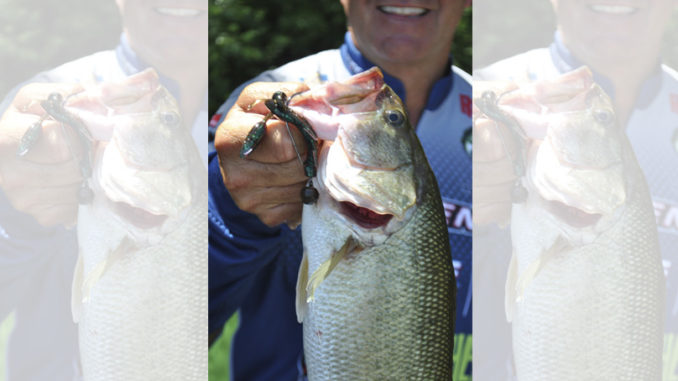
Don’t let heat, boat traffic keep you from catching bass
A lot of bass fishermen find good reasons to stay off our lakes during the peak of the summer. The heat and recreational boat traffic push many to stay home.
I can understand. Getting buzzed by jet skis is never fun. And with the temperature well up in the 90s, I see the wisdom of sitting in the air conditioning.
But I still love to fish for bass, and plenty of bass are there to be caught. So I try to fish regularly, even during July — and not necessarily at night. I like to fish deep, offshore structure. And I can do that and stay relatively cool.
The key is getting on the water early. I try to get out by 5 o’clock. That offers some good, predawn fishing. I aim to be off the water by 10 or 11 — just about the time the recreational traffic starts to stir things up.
Some bass stay shallow, even in extreme heat
Some fish will always stay shallow, and you can certainly fish shallow early in the morning and catch some fish on a buzzbait or a frog or some other topwater. But the majority of fish are out in deep water, waiting for my crankbait, Texas rig and or jig. With the advances in electronics, with sonar, down-imaging and side-imaging, it’s much easier now than it was 10 years ago to find fish when they’re deep.
When I fish a crankbait in May and June, I tend to fish in the creeks. But in July, I’m going to concentrate on the main lake, really, the main river channel. I’m typically looking for water that’s 20 to 30 feet deep. I’m looking with my Humminbird Helix 12 for cover or structure like stumps, brush piles, rocks, trees — anything that fish will use during the summer. Also, I’m looking for baitfish. And, with my down-imaging or side-imaging, I’m looking for fish that I can distinguish as bass — not catfish, white perch or crappie.
It’s important to understand that you may have water that’s 60 or 70 feet deep in the actual channel. But you’re looking for that 20- to 30-foot water that’s close by. Depending on the slope, those depths might be only 10 or 15 feet from the really deep water. Or it might be 100 yards away. This might sound like you’re looking for a needle in a haystack. But with my side-imaging, I can idle along and see 100 feet out to each side. So I can really cover a lot of water while I’m looking.
Hit cover and structure with crankbaits, soft plastics
If I see some cover or structure that I think might hold fish — but I can’t really see any fish, I’m going to fish those places with a crankbait or a Texas rig. If I can see what I’m pretty sure are bass, I’m going to fish it more slowly with a jig.
When I’m cranking, I’m using a Rapala DT-20 in a shad pattern. I like the Caribbean shad color, which has a little chartreuse on it with a blue back; a little bit of chartreuse is really good on any crankbait during the summer.
My other main weapon when the fish are in that 20-foot range is a 6-inch, Texas-rigged Senko with a 1/4- to 5/16-ounce VMC tungsten weight on a 4/0 or 5/0 hook. I fish it just like I’d fish a Texas-rigged ribbontail worm. A lot of fishermen lay down their Senkos after the spawn, but it’s really a good soft-plastic bait to fish year-round; I throw it later in the year than a lot of people do. As far as color, I think it’s hard to beat watermelon/red flake.
This time of year, the earlier, the better
If I’m fishing a little bit deeper, closer to 30 feet, I’m going to fish a VMC Swinging Rugby Head jig, usually 1/2- to 3/4-ounce, with a Flappin’ Hog as a trailer.
One thing I understand is that with social media, with YouTube and with all the information companies like Humminbird put out to help education fishermen about electronics, it’s much easier to learn how to use them, and they’re light years better than 20 years ago. With a little practice, you will learn to be able to recognize fish and what kind they are, as well as the kinds of things you can see on the bottom.
So don’t be afraid to plan a fishing trip in July. Get out and put in a good four or five hours before daylight and just after the sun rises, and take advantage of all the fish that have moved offshore. You’d be surprised that it’s just as exciting to dredge a big bass up off a brush pile in 20 feet of water on a crankbait as it is to catch one in three feet of water on a spinnerbait.




Be the first to comment